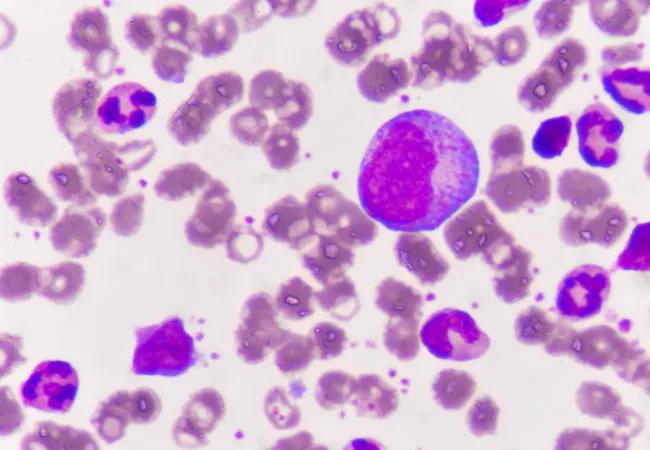TETi76 eliminates TET2-mutant and TET-deficient cancer cells

A novel strategy for selective targeting of TET2-mutant and TET-dioxygenase 2-deficient cells in myeloid neoplasms was reported in a recent study conducted by a group of Cleveland Clinic investigators and their collaborators. Study findings, published in Blood Cancer Discovery, have shown that treatment with a small-molecule TET inhibitor, TETi76, effectively suppresses the clonal evolution of TET2-mutant cells in mouse models and restricts the growth of TET-deficient leukemia in vivo. Importantly, treatment with this agent did not adversely affect the growth of normal hematopoietic precursor cells in vitro and in vivo.
Advertisement
Cleveland Clinic is a non-profit academic medical center. Advertising on our site helps support our mission. We do not endorse non-Cleveland Clinic products or services. Policy
“In our work, we have demonstrated for the first time that the defective mutated cancer cells can be preferentially targeted and eliminated while giving growth advantage to the normal hematopoietic stem and progenitor cells, the mother of all blood cells,” says research scientist Babal Kant Jha, PhD, co-corresponding author of the study. “In a preclinical in vitro and in vivo model we demonstrated that preferential targeting and elimination of such a clone, either at an early stage in clonal hematopoiesis of indeterminate potential (CHIP) or in fully developed disease, is possible.” Jaroslaw Maciejewski, MD, PhD, Chairman of the Department of Translational Hematology and Oncology Research, co-led the study and discovered the role of TET2 mutation in myeloid neoplasia in previous research.
Dr. Jha explains that the TET2 gene mutation is one of the most frequent mutations in myeloid neoplasia, ranging in frequency between 15% and 47% in different myeloid disorders. “In acute myeloid leukemia, its frequency is around 15%, in myelodysplastic syndrome (MDS) it is around 20%, and in chronic myelomonocytic leukemia it can go up to 47%,” he says. In healthy individuals, TET2 plays an important role in hematopoiesis, specifically in the self-renewal of stem cells and differentiation of monocytes; however, in individuals with a TET2 mutation, TET2 deficiency leads to aberrant myeloid differentiation and clonal expansion.
The loss of TET2 function can have additional implications on human health via the development of CHIP which increases the risk of cardiovascular disease and promotes the formation of atherosclerotic plaques. “The majority of TET2 mutations are discovered at the age of 50-55,” says Dr. Jha, which correlates with the age of onset of numerous cardiovascular disorders.
Advertisement
In designing their latest study, Dr. Jha and collaborators built on the previous finding that the survival and proliferation of myeloid precursors in individuals harboring the TET2 loss-of-function mutation is dependent on the residual TET activity that derives from TET3 and TET1, to some degree. They hypothesized that suppression of this residual DNA dioxygenase activity using a synthetic small molecule inhibitor may further suppress and possibly eliminate TET-deficient/TET2 mutant clones. They tested the efficacy and selectivity of TETi76 in a human leukemia cell lines and in the human TET2-/-leukemia cell line xenograft model.
“We demonstrated that this TET inhibitor preferentially inhibits TET activity under in vitro conditions as well as in vivo in a preclinical mouse model,” says Dr. Jha. “It also restricts the growth of the CHIP clone and it can also restrict the growth of leukemia cells. This is the first time, to the best of our knowledge, that TET inhibition was achieved using a small molecule.”
According to Dr. Jha, these findings may lead to a paradigm shift in the treatment of myeloid neoplasia and CHIP, and a focus on the development of new targeted agents that can effectively eliminate the malignant clone early in the disease process.
Drs. Maciejewski and Jha next plan to conduct studies to examine the safety and pharmacokinetics of TETi76. Depending on the results, they may decide to continue with further testing of TETi76 or refine/redesign the molecule and move forward with human clinical trials with a redesigned agent.
Advertisement
“If successful, one of the key effects of this concept will be that up to 40% of leukemia patients will be treated with this molecule or some version of this molecule or concept,” says Dr. Jha. Another potentially bigger impact, he adds, could be on cardiovascular disorders associated with the TET2 mutation and CHIP. Although it is currently possible to screen for CHIP, preventative interventions, or treatments for patients in whom CHIP is detected, are lacking.
“The question will be,” says Dr. Jha, “can we take this concept and treat the patient at the very first instance of CHIP occurrence? And can healthy individuals who present with CHIP be given agents capable of eliminating or restricting the CHIP clone at the foundation?”
Advertisement
Advertisement

First full characterization of kidney microbiome unlocks potential to prevent kidney stones

Researchers identify potential path to retaining chemo sensitivity

Large-scale joint study links elevated TMAO blood levels and chronic kidney disease risk over time

Investigators are developing a deep learning model to predict health outcomes in ICUs.

Preclinical work promises large-scale data with minimal bias to inform development of clinical tests

Cleveland Clinic researchers pursue answers on basic science and clinical fronts

Study suggests sex-specific pathways show potential for sex-specific therapeutic approaches

Cleveland Clinic launches Quantum Innovation Catalyzer Program to help start-up companies access advanced research technology